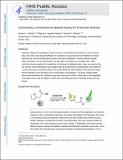Terbium(III) Luminescence-Based Assay for Esterase Activity
Author(s)
Hetrick, Kenton; Aguilar Ramos, Miguel A.; Raines, Ronald T
DownloadAccepted version (831.4Kb)
Publisher Policy
Publisher Policy
Article is made available in accordance with the publisher's policy and may be subject to US copyright law. Please refer to the publisher's site for terms of use.
Terms of use
Metadata
Show full item recordAbstract
Esterases catalyze the hydrolysis of esters to form a carboxylic acid and alcohol. These enzymes play a key role in both the detoxification of xenobiotic compounds and the metabolism of drugs and prodrugs. Numerous fluorogenic probes have been developed to monitor esterase activity. Most are based on an aromatic alcohol, and the others are based on an aromatic acid. These restrictions leave unexplored the specificity of esterases for aliphatic esters. Here, we report on the use of esters of thiopheneacetic acid coupled with the luminescence of terbium(III) as the basis for a continuous assay of esterase activity. This probe allows for a wide variation of the alcohol moiety and the detection of its hydrolysis at submicromolar concentrations. The assay verifies steady-state kinetic parameters for catalysis by pig liver esterase from either initial rates or the integration of progress curves, and its utility is evident with unpurified esterases in bacterial and human cell lysates.
Date issued
2019-06Department
Massachusetts Institute of Technology. Department of ChemistryJournal
Analytical Chemistry
Publisher
American Chemical Society (ACS)
Citation
Hetrick, Kenton J. et al. "Terbium(III) Luminescence-Based Assay for Esterase Activity." Analytical Chemistry 91, 13 (June 2019): 8615–8621 © 2019 American Chemical Society
Version: Author's final manuscript
ISSN
0003-2700
1520-6882